Minor planet 2014 UN271, discovered in data collected by the Dark Energy Survey, is set to make a close pass to Saturn’s orbit at the end of the decade, giving astronomers a chance to observe a rare trans-Neptunian object from up close…ish. Plus, Venus, Jupiter, the Milky Way, and an invisible galactic structure discovered quite by accident.
Podcast
Transcript
Hello and welcome to the Daily Space. I am your host Dr. Pamela Gay.
And I am your host Beth Johnson.
And we are here to put science in your brain.

Before we dive into the news, we have a quick NASA-politics update. In an act that somewhat mirrors the White House, a not-yet-retirement age woman has been named to NASA’s number two spot.
Yesterday, retired USAF officer and NASA astronaut Pam Melroy was sworn in as NASA Deputy Administrator. In a statement released by NASA, she says: It’s an honor to be confirmed by the Senate to serve as NASA Deputy Administrator, and I am humbled by President Biden and Vice President Harris’ confidence in me. I look forward to returning to the NASA family and working with Administrator Nelson to ensure the United States continues to lead in space and beyond – exploring the wonders of the universe, expanding the Earth science research critical to combating climate change, unlocking scientific discoveries that will change the world as we know it, and inspiring the next generation of discoverers and dreamers.
And now, to dive into that science!
While you should never judge a press release by its title, sometimes we journalists are going to give a release a more thorough reading if that title piques our curiosity. Enter the title, ‘Pack ice’ tectonics reveal Venus’ geological secrets. As a reminder, Venus has a surface temp of almost 870 degrees Fahrenheit, or 465 degrees Celcius, and has been known to melt the necessary bits of spacecraft.
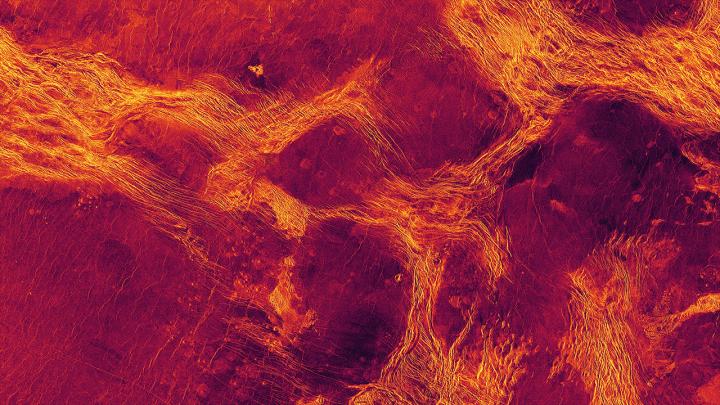
Ice and Venus are not words one expects related to one another.
And this is where we have to remember, “ice” is just a state of mind, or rather a state of matter. Ice just means something that was once liquid, and rock counts. In this case, researchers led by Paul Byrne and using Magellan radar data of Venus have discovered that the rock structures in Lavinia Planitia – which roughly translates as “lava plain” – have structures that look like pack ice that has tumbled and jostled together. According to Byrne: We know that much of Venus has been volcanically resurfaced over time, so some parts of the planet might be really young, geologically speaking. But several of the jostling blocks have formed in and deformed these young lava plains, which means that the [deeper rock layers] fragmented after those plains were laid down. This gives us reason to think that some of these blocks may have moved geologically very recently – perhaps even up to today.
In combination with other research on Venus’ modern atmosphere and structures called coronae that may be volcanic craters, there is building evidence that Venus either was geologically active very recently or still is today.
We really can’t wait for the next three Venus missions to get there and tell us what’s really going on. Since old astronomers and planetary scientists never retire, we hope to be bringing you the science from our senior homes, or at least from houses without stairs, a couple of decades from now.
This next story is one where I feel like I was part of the experiment.
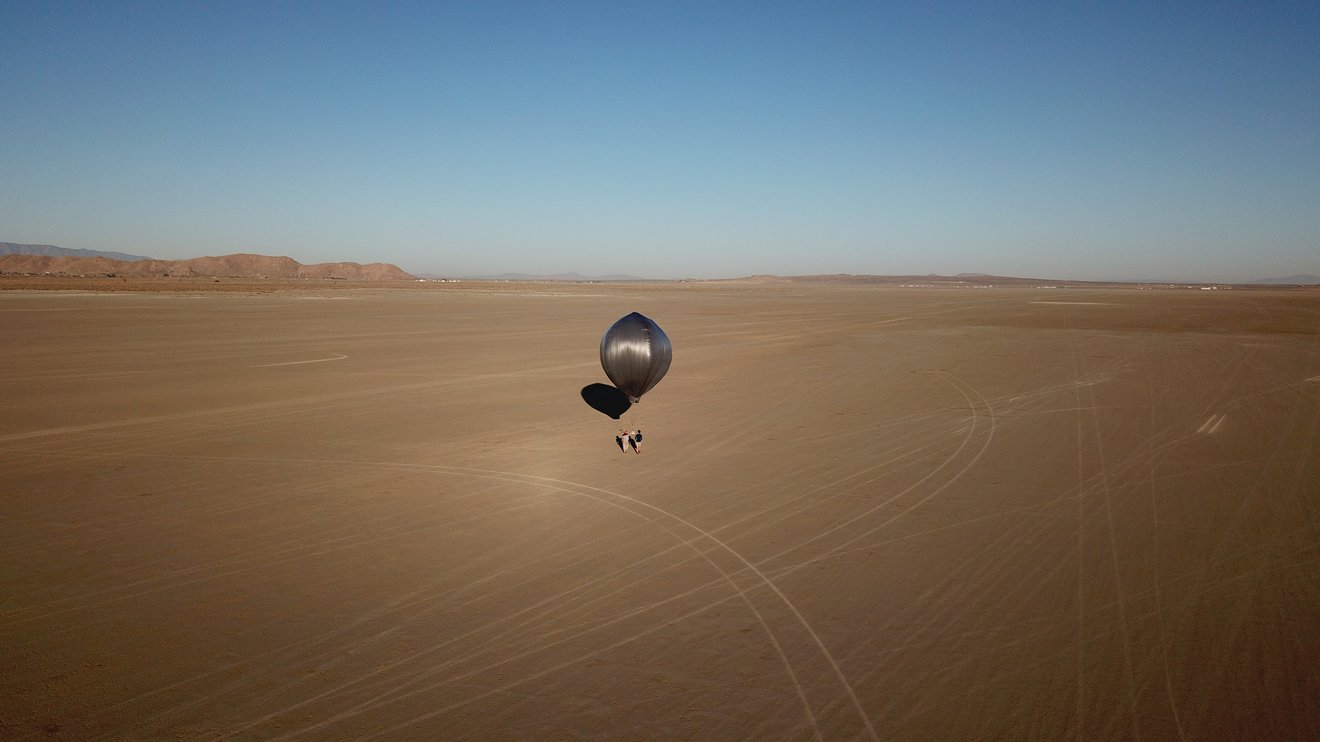
In July 2019, after attending a star party in Joshua Tree, I spent the Fourth of July holiday with dear friends in Los Angeles. On the morning of July 4, the house we were in, poised ever so delicately on the side of a rather steep hill, started to shake, rattle, and roll. I called out, “Earthquake!”, and for about thirty seconds we all kind of went, “Huh, this is lasting a while.” And then, in proper L.A. fashion, we went back to getting ready for brunch.
That magnitude 6.4 earthquake was part of a chain of quakes that would include a 7.1 trembler on July 6, which I didn’t feel because I was on the Transformers ride at Universal. While this earthquake is just a side note on a pleasant summer trip for me, for folks closer to the epicenter in Ridgecrest, CA, these quakes meant a lot of clean up and a fair amount of repair work; and for scientists at Caltech and the Jet Propulsion Laboratory, these quakes meant a chance to test balloon-carried earthquake detectors they hope to send to Venus.
While we normally detect quakes by how they literally shake the ground, this airborne sensor instead looks for slight changes in air pressure. On July 22, with their sensors at altitudes between 11-15 miles, they successfully detected low-frequency sound waves caused by aftershocks. This high altitude (well above commercial air traffic and in the land of weather balloons) makes observing earthquakes needlessly complicated, but on Venus, this exact same technique will allow scientists to study Venus quakes without melting their detectors – a factor that makes all the complications more than worth it.
And now, we’d like to remind you that one person’s interference can sometimes be someone else’s signal. In new research published in JGR: Planets and led by Heidi Becker, researchers use the star camera on the Juno spacecraft to look for high-energy ions. This camera is normally used to navigate the spacecraft by the stars and is highly shielded to prevent the typical high-energy particles in and around Jupiter from interfering with steering.
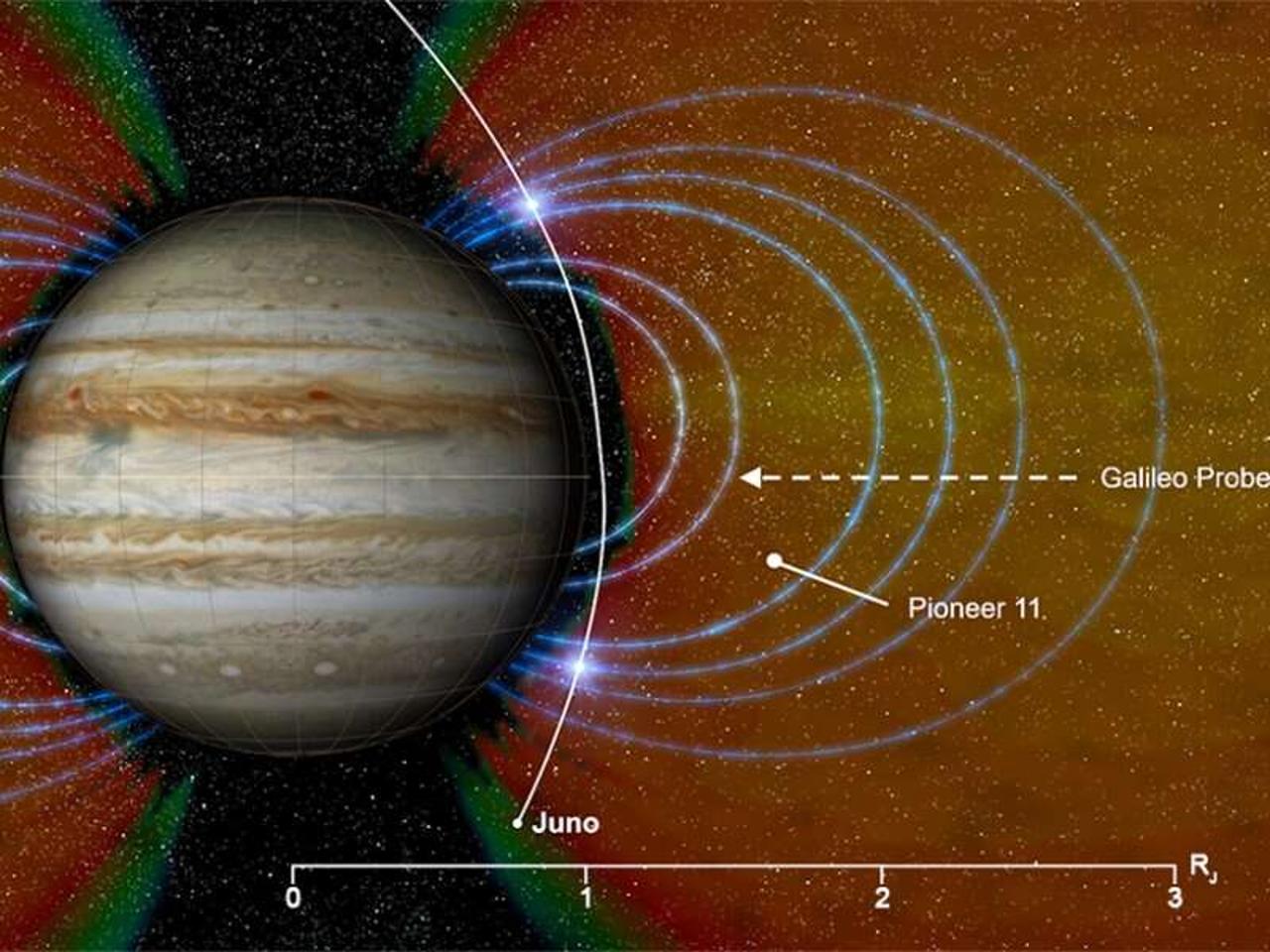
Highly shielded is not the same thing as completely shielded, however, and 118 different high-energy particles have struck the camera and left a trail or a blotch of overexposed pixels. As Juno orbits Jupiter from the equator to the pole and back again, it sees more of these particles as it passes magnetic latitudes of 31-46 degrees at a distance of 1.12-1.41 Jupiter radii. Juno is the first mission to explore this region. According to the paper: The ions are moving at close to light speed and may be composed of a combination of elements as light as helium or as heavy as sulfur. These are the highest energy particles detected by Juno. If encountered in great numbers, such ions are capable of causing spacecraft computer errors as well as damage to spacecraft electronics. Knowledge of the locations of these ion zones is important for the safe design of future missions to Jupiter and for understanding how radiation belts form around giant planets.
When the International Space Station (ISS) project was planned, there was a lot of talk about how it would serve as a port of call for scientists, engineers, and tourists as it became our best new platform for peace. In the decades that have followed, the ISS has served to bring nations of the world together in space, providing a home-away-from-home for Americans, Russians, Japanese, and other nations’ astronauts and cosmonauts. [Ed. note: Go watch Babylon 5, everyone!] What it hasn’t always done is perform cutting-edge research. All that began to change, however, with the addition of new instruments such as the NICER space telescope and CALET, the CALorimetric Electron Telescope.
The ISS provides a middle ground between “can’t easily be upgraded” self-orbiting spacecraft and the “fly out your grad students at will” easy-to-tinker-with ground telescopes. The Japanese Kibo experiment module on the ISS houses both exposed instruments on an outside terrace and also has a pressurized section. Exposed to space, CALET uses its detectors to look for fast-moving charged particles called cosmic rays. It has the capacity to detect not just the energy of what hits it but also the composition. Since its installation in 2015, CALET has detected teraelectronvolt particle after particle, and it is hoped that one day it might detect dark matter or at least the interactions of regular and dark matter.
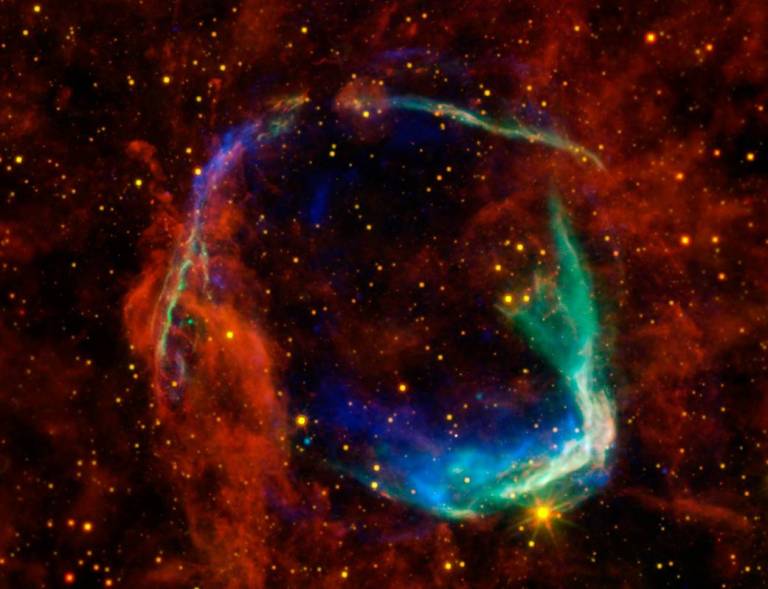
While it hasn’t yet seen that dark matter, it has seen some pretty weird stuff. In a new paper appearing in Physical Review Letters, researchers led by O. Adriani looked at the specific behaviors of cosmic rays made of iron as compared to other atoms like carbon, hydrogen, and oxygen. They find that while the three lighter-weight atoms all behave roughly the same, with similar distributions in their energies, iron is very different, and, as co-author Michael Cherry puts it: Something that needs to be emphasized is that the way the elements get from the sources to us is different, but it may be that the sources are different as well.
Cosmic rays interact with magnetic fields on their way from their source to our detectors. This can lead some heavy elements like iron to break down into smaller particles. We think. This means that when we see iron, it has probably – maybe – gotten to us in its primary state, while the other atoms may be origins of the cosmic ray formation or child particles. While we really don’t know the details on what’s going on, this research from CALET on the ISS tells us something is going on, and here is to hoping that with more years of data, we’ll not only figure out what that something is but also – maybe – detect dark matter.
Our next story is one that is just beginning, really. In an article first reported in New Scientist and rapidly being picked up everywhere else, a trans-Neptunian object has been found and confirmed using data from the Dark Energy Survey. The object, called 2014 UN271, was captured in data from 2014, 2016 and 2018, and is either a minor planet or a large comet, somewhere between 100 and 370 kilometers in diameter. [Ed. note: This body is now officially a comet named C/2014 UN271 (Bernardinelli-Bernstein).] Its orbit is about 600,000 years, with the furthest distance at 0.6 light-years, and incredibly eccentric or elliptical. And at the end of this decade, it will make its way almost to Saturn’s orbit.

One of the hopes for UN271 is that it will be a comet, and as it approaches closer and closer to the Sun, even at its great distance, it will show the characteristic signs of a coma, outgassing and glowing in the night sky. But before anyone gets too excited that this might be a big, showy comet, it won’t be. Citizen astronomer Sam Deen calculates that UN271 will only get as bright as Pluto or maybe Charon. This means it won’t be visible to the unaided eye, but observatories and telescopes should still be able to acquire some good images.
And there is even talk already of a potential mission to UN271. Mark McCaughrean at the European Space Agency has noted that any mission would have to launch in the next six or seven years to reach the object, and that timeline is doable. I suspect we’ll be hearing more and more about UN271 in the years to come. As Samantha Lawler at the University of Regina noted: We haven’t really seen any 100-kilometer [outer solar system] objects close up. Maybe it’ll be some totally bizarre shape.
She’s really hoping it has rings, and she’s made a bet on Twitter that it will.
While researching for this story, I got a lot of information from the scientists here at the Planetary Science Institute. One scientist noted that with all the orbital elements I mentioned earlier, UN271 is likely to be coming directly at Earth, appearance-wise, which means a lot of observations had to be taken to get those orbital elements and confirm them. Another scientist cautioned that making any calculations from this distance is unreliable.
At this point, though, UN271 has already crossed Neptune’s orbit. It’s already in the main part of our solar system, y’all. And astronomers are making observations. A team used the SkyGems Remote Telescope in Namibia to image UN271 and reported that there is clear evidence for cometary activity, capturing images of an elongated tail. The magnitude is down between 18 and 20, and we’ll have links for finding UN271 at our website, DailySpace.org.
I am pretty excited about UN271. There’s a lot we don’t know about trans-Neptunian objects and outer solar system comets, so no matter what this object actually is, we will learn a lot from observing it. And if someone can get a spacecraft out there, even better.
One of the things that will never stop taking my breath away is the discovery of new, large objects that are shining faintly in plain sight. From the excitement of a mega comet or a melty minor planet, we now turn to a massive molecular cloud of cold gas lurking in the Milky Way.
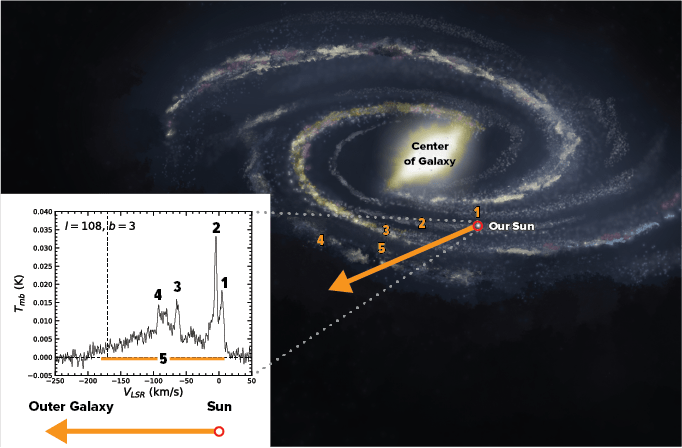
Cold gas gives off no optical light of its own. If it is diffuse enough, it also doesn’t significantly block background light. And if that cold gas is mostly made of molecular hydrogen, it is going to be basically invisible even to radio telescopes. Luckily, clouds of molecular gas aren’t generally made of just one atom, and mixed in with that molecular hydrogen should be other gases.
Over the years, astronomers mapping the molecular clouds in our galaxy have generally used easy-to-observe carbon monoxide as a tracer of where atomic hydrogen is located, but in 2012, astronomer Ron Allen found radio omissions from hydroxide (OH) in a region of the sky where no carbon monoxide was found. Hydroxide and carbon monoxide both usually trace atomic hydrogen, and the question became: Can there be carbon-monoxide-dark molecular clouds? Early computer models said yes, and observation after observation also seemed to say yes.
A single, curious, region of the sky was found to be emitting cosmic rays that seemed to indicate something was out there. It also was glowing faintly in OH and patchily in carbon monoxide. This signal was observed in scope after scope and didn’t go away with better observations; it just didn’t ever particularly stand out. Much to everyone’s frustration, this is a massive blob of cold gas that is cold enough to be largely invisible, but it shined ever so faintly in the Green Bank Observatory’s twenty-meter telescope and appears to be a source of cosmic rays.
These results will now need to be factored in when folks try to model future star formation and the ratio of dark matter to luminous matter in our solar system.
And this is your reminder that the total amount of dark matter needed to understand our galaxy has gone down ever so small an amount as we’ve gotten better and better at finding cold gas. While we remain certain that some strange stuff that refuses to interact with light will one day be found, this discovery tells us that we might need to find a snert less of that stuff than we were expecting.
For now, though, this has been the Daily Space.
Learn More
Pam Melroy Named NASA Deputy Administrator
‘Pack Ice’ Tectonics Reveal Venus’ Geological Secrets
- ‘Pack ice’ tectonics reveal Venus’ geological secrets (EurekAlert)
- “A globally fragmented and mobile lithosphere on Venus,” Paul K. Byrne et al., 2021 June 29, PNAS
California Quakes Provide Testing for Venus Tech
- NASA JPL press release
- “The First Detection of an Earthquake From a Balloon Using Its Acoustic Signature,” Quentin Brissaud et al., 2021 May 20, Geophysical Research Letters
Jupiter’s Magnetic Field Creates Dangerous Ions
- Juno Detects Jupiter’s Highest-Energy Ions (Eos)
- “High Latitude Zones of GeV Heavy Ions at the Inner Edge of Jupiter’s Relativistic Electron Belt,” Heidi N. Becker et al., 2021 May 10, JGR Planets
Instrument on ISS Tells Story of High-Energy Atoms
- UMBC press release
- Japanese, Italian, US physicists reveal new measurements of high-energy cosmic rays (EurekAlert)
- “Measurement of the Iron Spectrum in Cosmic Rays from 10 GeV/n to 2.0 TeV/n with the Calorimetric Electron Telescope on the International Space Station,” O. Adriani et al., 2021 June 14, Physical Review Letters
2014 UN271 to Make Close Pass to Saturn’s Orbit
- An enormous ‘mega comet’ is flying into our solar system (New Scientist)
- Extremely eccentric minor planet to visit inner solar system this decade (New Atlas)
- 2014 UN271: A possible dwarf planet from the Oort Cloud on a tour through the Solar System (MPLM Forum)
- Minor Planet Electronic Circular 2021-M53: 2014 UN271 (Minor Planet Center)
Cloud of Cold Molecular Gas Discovered by Accident
- Green Bank Observatory press release
- “Observational Evidence for a Thick Disk of Dark Molecular Gas in the Outer Galaxy,” Michael P. Busch, Philip D. Engelke, Ronald J. Allen, and David E. Hogg, 2021 June 16, The Astrophysical Journal
Credits
Written by Pamela Gay and Beth Johnson
Hosted by Pamela Gay and Beth Johnson
Audio and Video Editing by Ally Pelphrey
Content Editing by Beth Johnson
Intro and Outro music by Kevin MacLeod, https://incompetech.com/music/


 We record most shows live, on Twitch. Follow us today to get alerts when we go live.
We record most shows live, on Twitch. Follow us today to get alerts when we go live.